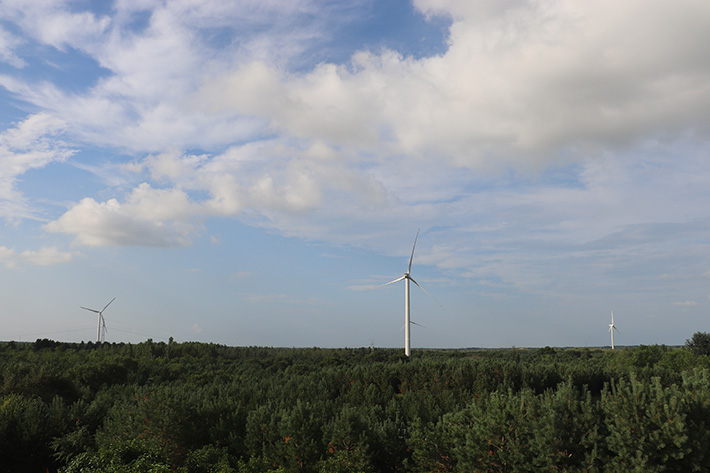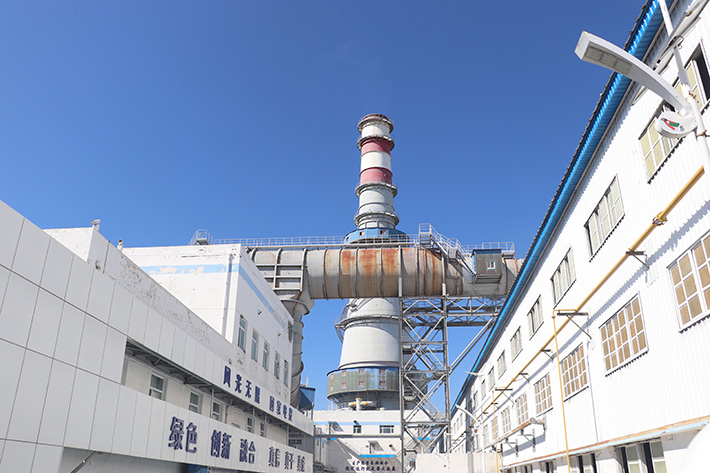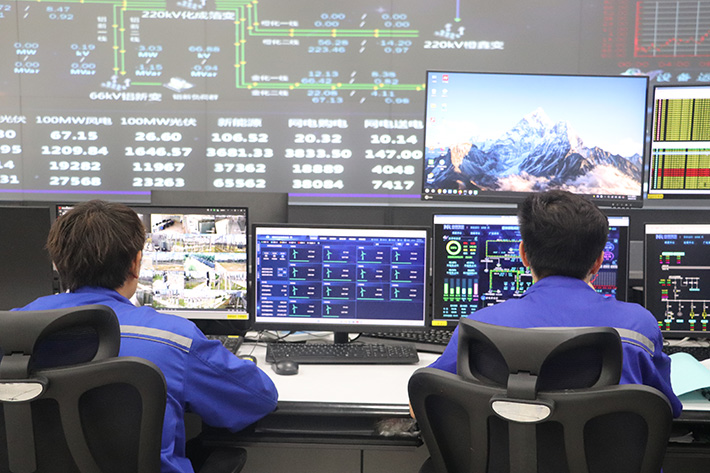|
||||||||||
| Home Top News Economy/Tech Culture/Sports China in Foreign Eyes Green Development Videos Intangible Cultural Heritages |
|
||||||||||
| Home Top News Economy/Tech Culture/Sports China in Foreign Eyes Green Development Videos Intangible Cultural Heritages |
| ChinAfrica |
| Green Synergy |
| Clean energy boosts industrial development in Tongliao |
| By Hu Fan | VOL. 17 October 2025 ·2025-10-10 |

Wind turbines rise above the forest in Nugusitai Town, Tongliao, Inner Mongolia Autonomous Region, on 28 July (HU FAN)
Energy has long played an indispensable role in the economic growth of Tongliao, a city on the eastern edge of Inner Mongolia Autonomous Region. The city’s abundant coal reserves once provided a competitive advantage, fuelling the energy-intensive process of aluminium production. Over the years, Tongliao grew into the largest aluminium industry base in northeast China, with aluminium-related sectors becoming a central pillar of its industrial output.
As China accelerates its efforts to meet its “dual carbon” objectives - reaching peak emissions before 2030 and achieving carbon neutrality by 2060 - Tongliao’s industrial landscape is undergoing a major transformation. Energy once again drives this change, but this time it is sourced not from coal, but from the sun and wind. Through expanding renewable energy generation and greening traditional heavy industries, Tongliao is forging a pioneering path where clean energy and industrial growth go hand in hand.
Greening aluminium production
In Holingol, a county-level city in Tongliao where the aluminium industry is most concentrated, Inner Mongolia Huomei-Hongjun Aluminium & Electricity Co. Ltd. has emerged as a pioneer of this transformation. In its workshops, automated machinery runs electrolytic processes, removes impurities, prints labels, and stacks aluminium ingots, with only a few workers monitoring the equipment.
“The environment here is nothing like the traditional workshops with heat and dust,” said 30-year-old Pan Yanzhi, now a production supervisor. She was the company’s first female electrolytic worker and has seen first-hand how automation has made conditions safer and cleaner, while boosting efficiency.
The company has also made substantial investments in emission controls. In 2017, it launched a 310-million-yuan ($43.6 million) ultra-low emission project using limestone-gypsum technology to cut pollutants such as fluorides, sulphur dioxide, and particulates to levels far below national standards. The project won top national awards for technological innovation and equipment management, cementing its role as an industry benchmark.
Aluminium smelting relies on passing a powerful direct current through molten alumina at temperatures close to 950 degrees Celsius, producing liquid aluminium at the cathode. The liquid aluminium is then either sent directly to downstream processors or cast into ingots. In the company’s electrolytic workshops, producing 1 tonne of aluminium requires 13,300 kwh of electricity. With an annual output of 860,000 tonnes, its demand for power is immense.
Centred on aluminium production, the company has developed a circular economy model that links coal, renewable energy, electricity, and aluminium. By the end of 2024, it had installed 1.8 million kw of coal-fired capacity and 1.05 million kw of renewable capacity, together supporting its aluminium smelting operations.
More than 30 billion kwh of renewable electricity were consumed on-site in 2024, enabling the production of nearly 70,000 tonnes of “green aluminium.” This meant that 27.5 percent of the renewable energy generated was used locally - one of the highest levels nationwide - equivalent to saving over 900,000 tonnes of standard coal and reducing carbon dioxide emissions by 2.6 million tonnes in a single year.

An ultra-low emission facility of Inner Mongolia Huomei-Hongjun Aluminium & Electricity Co. Ltd. in Tongliao, Inner Mongolia Autonomous Region, on 28 July (HU FAN)
Harnessing the wind and sun
Tongliao’s natural resources position it well for a renewable revolution. The city has exploitable wind and solar potential of nearly 60 gw, making it a national-scale wind and solar base. By mid-2025, Tongliao had built 14.1 gw of renewable capacity, with another 3.36 gw under construction and 6.82 gw approved for development. Renewable energy now accounts for almost two-thirds of the city’s new power capacity, and annual generation continues to rise.
Collaboration has also expanded beyond municipal borders. According to Guo Jinghua, deputy director of the municipal energy bureau, Tongliao has joined hands with neighbouring Hinggan League to develop integrated projects combining generation, storage, and industrial consumption.
“Land eligible for developing wind and solar power projects is limited, so such collaboration is essential, especially in north Tongliao, where demand from the aluminium industry is high,” Guo said.
Eight such joint projects, with combined capacity of 2.79 gw, are underway. Once complete, they are expected to bring Hinggan League 13 billion yuan ($1.8 billion) in investment and 2.9 billion yuan ($407.6 million) in annual output, while providing 9 billion kwh of green electricity to Tongliao.
To make sure this clean energy is not wasted, Tongliao is investing heavily in storage. Nine energy-side storage projects, totalling nearly 900 mw, are already in place. Another six independent grid-side storage stations, including two large-scale projects of 1,000 mw each, are planned to come online by the end of this year. In addition, the city is advancing a multi-billion-yuan pumped storage power station, designed to add 1.2 gw of flexible capacity.
To promote renewable energy consumption, reforms to local distribution networks are also under way. By supplying cheaper, locally generated electricity – particularly clean energy – these networks attract companies that are highly sensitive to energy costs.
A prime example of this transformation is the distribution network serving the Holingol High-Tech Zone. It provides power to 46 companies in the zone, with renewable sources accounting for 63 percent of the energy mix. This has reduced electricity prices to a level below those of the national grid.
“Renewable energy has two advantages in our network: It is cheaper than coal-fired electricity, and it helps us to meet carbon reduction requirements,” said Zhao Heming, deputy general manager of Holingol Electric Power Investment Co., Ltd., which operates the network.
In Hure Banner, the shift towards new energy is reaching right to the doorsteps of farmers and herders. New energy is helping to secure energy supply in rural areas and creating favourable conditions for the electrification of daily life, from cooking to heating.

Technicians monitor operations in the control centre of an electricity distribution network in the Holingol High-Tech Zone, Tongliao, Inner Mongolia Autonomous Region, on 28 July (HU FAN)
Expanding green industries
For Tongliao, green energy is not just about providing cleaner electricity, but about transforming entire industrial supply chains. By aligning energy supply with industrial demand, the city is creating a blueprint for coordinated green development.
The aluminium sector, which has long served as the city’s industrial backbone, is advancing up the value chain, shifting from basic extrusion to advanced processing.
So far, the city has attracted 29 downstream enterprises specialising in high-performance aluminium alloys, automotive lightweighting, electronic foils, and other advanced products. These ventures have collectively established a processing capacity of 3.42 million tonnes, producing everything from household foil to automotive profiles and spherical aluminium powders. Notably, in niche markets such as battery foils, spherical powders, and car body materials, Tongliao now commands a significant share of the nation’s capacity.
Other sectors are following suit. In green equipment manufacturing, the city has harnessed renewable energy demand to establish a comprehensive industrial chain for wind power components. A growing cluster of companies now produces key components like turbines, blades, towers, and hubs, with annual production capacities in the thousands.
Digital industries are also integral to Tongliao’s green vision. Plans are underway to establish a sustainable data centre that will be fully powered by renewable energy. By 2035, the city aims for over 60 percent of the centre’s power to come directly from renewables, reinforcing its goal of becoming a regional leader in green computing power.
As Tongliao moves forward on this green trajectory, the synergy between clean energy and industry is reshaping its economic foundation. It is proof that a city’s future competitiveness can be built as much on clean air and innovation as on natural resources and tradition.
| About Us | Contact Us | Advertise with Us | Subscribe |
| Copyright Beijing Review All rights reserved 京ICP备08005356号-5 京公网安备110102005860号 |